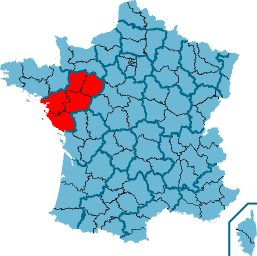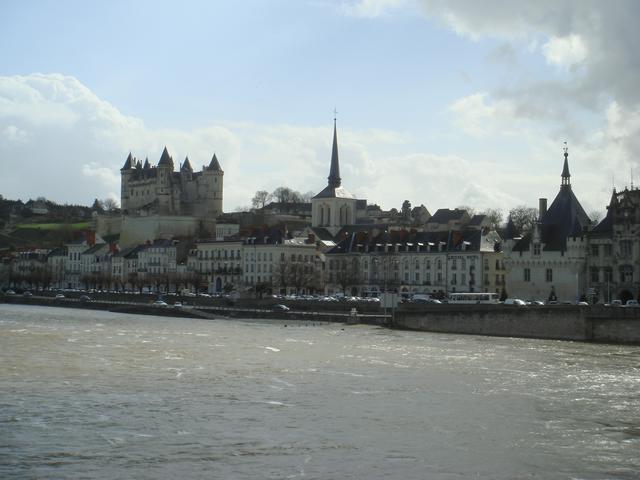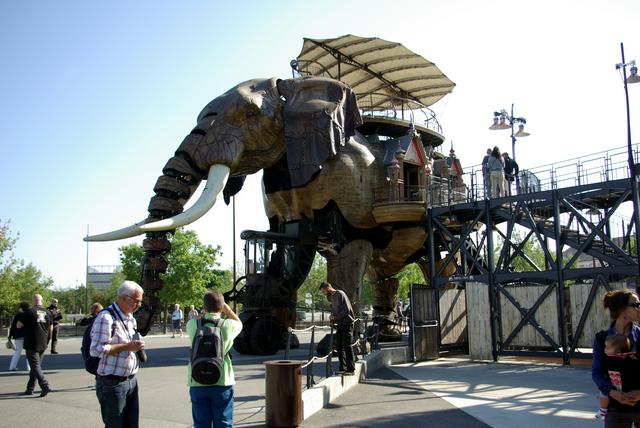
The Pays de la Loire is an extensive region of north-western France to the west and south-west of Paris, separated from it by the adjoining region of Centre-Val de Loire with which it shares many affinities. Both regions border on the Loire Valley and host famous châteaux. The Pays de la Loire is somewhat more diverse, however, and has a long coastline along the Atlantic Ocean, forming the northern part of the Bay of Biscay, within the area known as the Vendée.

- Nantes. is the capital of the Pays de la Loire, though many consider it part of Brittany.
- Angers. is a medium sized city which is the capital of the Maine-et-Loire department.
- Château Gontier.
- Clisson. is about from Nantes
- Durtal.
- Fontenay-Le-Comte.
- Guerande. a walled city known for locally produced Breton salt in Salt Marshes
- La Baule. or La Baule-Escoublac, is a city on the Atlantic ocean coast, in the département of Loire-Atlantique
- Le Mans. is best known for its annual 24 Hours automobile race.
- Les Sables d'Olonne. is a subprefecture in Vendee
- Montsoreau. is a small historical town, known for its château; the only château of the Loire Valley to have been built in the Loire riverbed, today a museum of contemporary art.
- Saint-Nazaire. is a port town at the mouth of the Loire, near Nantes.
- Saumur. is a small historical town, site of a dramatically situated château and the heart of its own world-renowned wine district.
Nantes. is the capital of the Pays de la Loire, though many consider it part of [[Brittany]].
Angers. is a medium sized city which is the capital of the Maine-et-Loire department.
Château Gontier.
Clisson. is about from [[Nantes]]
Durtal.
Fontenay-Le-Comte.
Guerande. a walled city known for locally produced Breton salt in Salt Marshes
La Baule. or La Baule-Escoublac, is a city on the Atlantic ocean coast, in the département of Loire-Atlantique
Le Mans. is best known for its annual 24 Hours automobile race.
Les Sables d'Olonne. is a subprefecture in [[Vendee]]
Montsoreau. is a small historical town, known for its château; the only château of the [[Loire Valley]] to have been built in the Loire riverbed, today a museum of contemporary art.
Saint-Nazaire. is a port town at the mouth of the Loire, near [[Nantes]].
Saumur. is a small historical town, site of a dramatically situated château and the heart of its own world-renowned wine district.
- Château-du-Loir. is a small market town on the river Le Loir in the south of Sarthe.
- Fontevrault. (more fully, Fontevrault-L'Abbaye) is an historic town in the Loire Valley.
- La Flèche. is a town on the Loire river in the French department of Sarthe.
- L'Île-d'Yeu. is an island and commune just off the Vendée coast of western France.
- L'Île-D'Elle.
- Montreuil-Bellay.
Château-du-Loir. is a small market town on the river Le Loir in the south of [[Sarthe]].
Fontevrault. (more fully, Fontevrault-L'Abbaye) is an historic town in the [[Loire Valley]].
La Flèche. is a town on the Loire river in the French department of [[Sarthe]].
L'Île-d'Yeu. is an island and commune just off the Vendée coast of western France.
L'Île-D'Elle.
Montreuil-Bellay.
The language here is much the same as the rest of France, with more northern than southern influences due to the influences from Paris, and basic French will be easily understood. English will generally be understood in tourist destinations and in major cities, especially by younger people. Spanish and German are also commonly understood.
A small part of the region prides itself on its use of the Breton language (the language of Brittany) but this is mostly a tradition and Breton is only taught as a second language nowadays.
- Loire Valley. The Loire Valley is the 3rd touristic destination in France. It is the largest site in France ever inscribed on UNESCO's World Heritage List under the heading of Living Cultural Landscapes. Kings, artists and famous authors, seduced by the Loire, were many to take up residence on the banks of the "Royal River". You can enjoy Renaissance Chateaux, medieval fortresses, historical gardens or unspoiled landscapes by car, by foot, by bicycle or on board a bareg. Wine, music, litterature, art, sailing, and food are also part of this legacy.
- Castle of Angers.
- Chateau de Montsoreau-Museum of Contemporary Art, Passage du Marquis de Geoffre 49730 Montsoreau, +33 2 41 67 12 60. The Château de Montsoreau-Museum of Contemporary Art is the only chateau of the Loire Valley to have been built in the Loire riverbed. Its collection represent the world largest holding of Art & Language works. 9.5 euros.
- Castle of Saumur. Museum of decorative arts.
- Castle of Brézé.
- Castle of Nantes.
- Castle of Brissac.
- Abbey of Fontevraud.
- Cadre Noir.
- Castle of Montreuil-Bellay.
- Castle of Serrant.
Loire Valley. The Loire Valley is the 3rd touristic destination in France. It is the largest site in France ever inscribed on UNESCO's World Heritage List under the heading of Living Cultural Landscapes. Kings, artists and famous authors, seduced by the Loire, were many to take up residence on the banks of the "Royal River". You can enjoy Renaissance Chateaux, medieval fortresses, historical gardens or unspoiled landscapes by car, by foot, by bicycle or on board a bareg. Wine, music, litterature, art, sailing, and food are also part of this legacy.
Castle of Angers.
Chateau de Montsoreau-Museum of Contemporary Art, Passage du Marquis de Geoffre 49730 Montsoreau, +33 2 41 67 12 60. The Château de Montsoreau-Museum of Contemporary Art is the only chateau of the Loire Valley to have been built in the Loire riverbed. Its collection represent the world largest holding of Art & Language works. 9.5 euros.
Castle of Saumur. Museum of decorative arts.
Castle of Brézé.
Castle of Nantes.
Castle of Brissac.
Abbey of Fontevraud.
Cadre Noir.
Castle of Montreuil-Bellay.
Castle of Serrant.
- Chateau de Montsoreau-Museum of Contemporary Art, Passage du Marquis de Geoffre 49730 Montsoreau, +33 2 41 67 12 60. The Château de Montsoreau-Museum of Contemporary Art is the only chateau of the Loire Valley to have been built in the Loire riverbed. Its collection represent the world largest holding of Art & Language works. 9.5 euros.
- Castle of Angers. The castle of Angers shows in its rooms the tapestries of the Apocalypse, which are one of the world largest set of tapestries of the 14th century.
- Angers Museum of fine arts.
- Nantes Museum of arts.
- Castle of Saumur. Museum of decorative arts.
Chateau de Montsoreau-Museum of Contemporary Art, Passage du Marquis de Geoffre 49730 Montsoreau, +33 2 41 67 12 60. The Château de Montsoreau-Museum of Contemporary Art is the only chateau of the Loire Valley to have been built in the Loire riverbed. Its collection represent the world largest holding of Art & Language works. 9.5 euros.
Castle of Angers. The castle of Angers shows in its rooms the tapestries of the Apocalypse, which are one of the world largest set of tapestries of the 14th century.
Angers Museum of fine arts.
Nantes Museum of arts.
Castle of Saumur. Museum of decorative arts.
- Bretesche Castle.
- Apremont Chateau
- Grand Lieu Lake
- Atlantic Coast
- Loir Valley.
- Puy du Fou historical theme park. With over 1,5 million visitors a year, this is one of the most popular attractions in the whole of France. It has 5 main attractions, including a birds of prey show and a Roman style gladiator fight and a number of smaller ones. All spectacles are in French, but for the main ones electronic translators are available. During peak season, there's a regular "Cinescene", a huge show depicting 700 years of history in the region, but you'll need to book separate tickets for it. €31 for adults, kids €22. Booking in advance will give a 3 euro discount..
- The Airbus factory and the Chantiers de l'Atlantique shipwright are located Saint-Nazaire and can be visited.
Bretesche Castle.
Loir Valley.
Puy du Fou historical theme park. With over 1,5 million visitors a year, this is one of the most popular attractions in the whole of France. It has 5 main attractions, including a birds of prey show and a Roman style gladiator fight and a number of smaller ones. All spectacles are in French, but for the main ones electronic translators are available. During peak season, there's a regular "Cinescene", a huge show depicting 700 years of history in the region, but you'll need to book separate tickets for it. €31 for adults, kids €22. Booking in advance will give a 3 euro discount..
The Airbus factory and the Chantiers de l'Atlantique shipwright are located [[Saint-Nazaire]] and can be visited.
The Atlantic ocean coast is a major tourist attraction in summer, with a peak from June to late August. Major seaside resort cities include La Baule, Les Sables d'Olonne, Pornic, Saint Jean-de-Monts, Piriac-sur-Mer and Pornichet. Several islands are also important touristic destinations such as Belle Île, L'Île d'Yeu and Noirmoutier. Fans of sailing shouldn't miss the Vendée Globe regatta, departing every four years from Les Sables d'Olonne.
The Loire river joins the Atlantic Ocean in Saint-Nazaire. The Loire river from Nantes to Saint-Nazaire is mostly boarded by industrial and commercial port facilities, but upstream from Nantes, the banks are much nicer. A long-distance hiking trail, the GR3, follows the river, going from castle to castle. An EuroVelo bike trail (EV6) follows much the same path. Many famous Loire castles are in the Pays-de-la-Loire region, including the castle of Angers, the Castle of the Dukes of Britany in Nantes, the castles of Saumur, Brézé or Ancenis. The castle of Brissac in Maine-et-Loire is the tallest in France.
The Puy du Fou theme park in Vendée is a medieval theme park. It is the most visited tourist attraction in the region and has won numerous awards for the quality of its shows. A large part of the workers are the park are volunteers from the local community.
 As the main city of the region, Nantes features a hots of museums, including its famous Natural History museum, the Jules Verne Museum and the Château des Ducs de Bretagne (Dukes of Brittany Castle). It is also famous for its exhibition of the Machines de l'île (Machines of the Isle of Nantes), featuring giant animatronic animals including a life-sized elephant. The Lieu Unique ("The Unique Place") is a cultural center and hammam located in the former factory of the LU biscuit company, a few steps away from the main station.
As the main city of the region, Nantes features a hots of museums, including its famous Natural History museum, the Jules Verne Museum and the Château des Ducs de Bretagne (Dukes of Brittany Castle). It is also famous for its exhibition of the Machines de l'île (Machines of the Isle of Nantes), featuring giant animatronic animals including a life-sized elephant. The Lieu Unique ("The Unique Place") is a cultural center and hammam located in the former factory of the LU biscuit company, a few steps away from the main station.
The Vendée area has a proud history of standing up to the French Republic, having been the main area resisting the French Revolution. That history is featured at the Historial de la Vendée Museum and in the Military Museum in Sainte-Gemme-La-Plaine. Other major museums in Vendée include the Cité des Oiseaux ornithological museum, the Biotopia nature exhibit and the Chocolate Museum in La Roche-sur-Yon.
The famous Royal Abbey of Fontevraud is located in Fontevraud-l'Abbaye in Maine-et-Loire. It is a former monastery and a UNESCO World Heritage site, and hosts the Cultural Center of the West.
The Pays-de-la-Loire region is quite varied culinarily. Its historical ties with Brittany strongly marked the food tradition in the north of the region, while the coast features all kinds of seafood dishes. The Vendée area also has a strong culinary identity. A region-wide tradition everyone should try is salted butter with large crystals of salt: inhabitants of Pays de la Loire would not have it otherwise.
Brittany's most famous specialty is by far their delicious crêpes, pancakes of wheat or buckwheat, eaten with sweet or savory garnish. Restaurants serving them are called crêperies and will often serve only that. Small kiosks on the street may serve crêpes as well, generally of lower quality and sometimes sweet only. A tourist in the region should try at least one meal of crêpes only, with a savory main course (the most common would be a "complete": eggs, ham and cheese) and a sweet crêpe for dessert. Other specialties from Brittany include the saucisse bretonne, a saussage traditionally eaten wrapped in a buckwheat crêpe, and l'andouille de Guémené, another type of sausage. On the sweet side, the Far Breton cake is a rich cake, served with or without prunes. The Kouign-Amann is another sweet pastry famous for the large quantities of butter used in its making. And you can always top anything with a generous serving of sea-salt caramel ("caramel au beurre salé").
Seafood is found everywhere but coastal cities will get you the best of the best. Oysters and mussels are favorites. Fish is often served with beurre blanc sauce, whose invention is disputed between Angers and Nantes. Salt is produced all along the coast, and the finest fleur-de-sel is made either in Guerande or in Noirmoutier depending on who you ask. In the salt pans, producers also grow the salicorne, a very flavorful seaweed served in salads or as a side.
Cheese is plentiful throughout the region. Typical of France, almost every city has its type of cheese. Famous ones include the Port-Salut, the Curé Nantais, and the Crémet d'Anjou.
Biscuits are a tradition in Nantes, where the largest biscuit factories from B.N. and LU were located. You can still visit the old LU factory in central Nantes. Other local sweets in Nantes include the berlingot nantais, a form of hard candy.
Highly regarded potatoes are grown on the island of Noirmoutier, using seaweed for fertilizer. Locals recommend the early potatoes ("pommes de terre nouvelles"), which are smaller but greater in texture and flavor.
The city of Challans in Vendée is famous nationwide for its chicken, best eaten roasted.
The region grows grape, a lot of it, and makes many wines. The most famous, if you ask a French person, is probably the Muscadet, a white wine that is kept with the lees (the dead yeast) for a full winter, giving it a yeasty, tangy flavor with a light body. Gamay, red or rosé, is typical of the Loire-Atlantique wineries, as well as Gros-Plant. Red Gamay is light-bodies with fruity flavors, and will please amateurs of the more famous Pinot Noir. In Anjou, the white Coteaux du Layon has a beautiful golden robe and will please those who enjoy a sweet white wine.
Crime is generally low, although highly touristic areas in the major cities and along the coast will have some level of pickpockets and scammers.
The city of Nantes is infamous for its protests which can get quite violent. Avoid the center of the city if you see a large protest as cops are known to indiscriminately target people, protesters or not.
Despite having a great network of dual carriageways, some of the country roads are narrow, bendy and unsuitable for their 90kph speed limits. Take your time and enjoy the dramatic scenery of the region.
Travellers wishing to see more of the Loire Valley can continue further east into the adjoining Centre-Val de Loire region, studded with additional historical cities and chateaux at sites such as Bourges and Saint-Benoît-du-Sault.
Travellers who enjoy the Atlantic coast can go south to Nouvelle-Aquitaine or north to Brittany.
